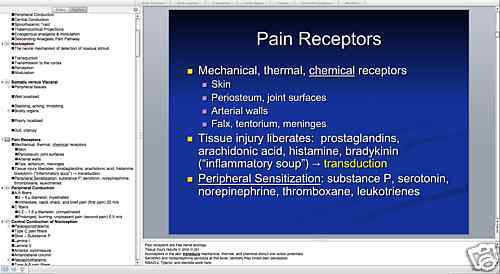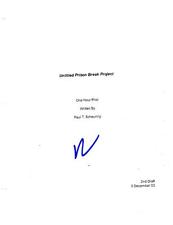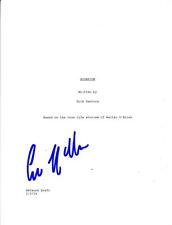65 page PSYCHIATRY Of PAIN PowerPoint Presentation CD For Sale

When you click on links to various merchants on this site and make a purchase, this can result in this site earning a commission. Affiliate programs and affiliations include, but are not limited to, the eBay Partner Network.
65 page PSYCHIATRY Of PAIN PowerPoint Presentation CD:
$11.99
Thank you!
If you do not wish to have your item(s) delivered on data disc(s), I can provide them on a flash drive and other means as well. Just let me know if a disc does not work for you and we can discuss delivery by other methods.
COMBINING SHIPPING COSTS
Are you purchasing multiple items? I will: a) combine all invoices before payment and charge shipping equivalent to one item, or b) refund all shipping costs in excess of one item after payment.
All derivative (i.e. change in media; by compilation) work from this underlying U.S. Government public domain/public release data is COPYRIGHT © GOVPUBS
$3.00 first class shipping in U.S.
Includes the Adobe Acrobat Reader for reading and printing publications.
Contains the following key public domain (not copyrighted) U.S. Government publication(s) on one CD-ROM in both Microsoft PowerPoint and Adobe Acrobat PDF file formats:
TITLE:
Pain: The Psychiatry Perspective, 65 pages (slides)
SLIDE TOPICS, SUBTOPICS and CONTENTS:
Pain: The Psychiatry Perspective
CPT Gabriel Cuka, MD
October 13, 2006
Outline
Broad Excluded: Headache International Association for the Study of PainPain is an unpleasant sensory and emotional experience arising from the actual or potential tissue damage or described in terms of such damage.
Pathophysiology of Pain
Nociception
Peripheral Conduction
Central Conduction
Spinothalamic Tract
Thalamocortical Projections
Endogenous analgesia & modulation
Descending Analgesic Pain Pathway
Nociception
The neural mechanism of detection of noxious stimuliTransduction
Transmission to the cortex
Perception
Modulation Somatic versus Visceral
Peripheral tissuesWell localizedStabbing, aching, throbbing
Bodily organsPoorly localizedDull, crampyPain Receptors
Mechanical, thermal, chemical receptors
Skin
Periosteum, joint surfaces
Arterial walls
Falx, tentorium, meninges
Tissue injury liberates: prostaglandins, arachidonic acid, histamine, bradykinin (“inflammatory soup”) -> transduction
Peripheral Sensitization: substance P, serotonin, norepinephrine, thromboxane, leukotrienes
Peripheral Conduction
A-? fibers
2 – 5 ? diameter, myelinated
Immediate, rapid, sharp, and brief pain (first pain) 20 m/s
C fibers
0.2 – 1.5 ? diameter, unmyelinated
Prolonged, burning, unpleasant pain (second pain) 0.5 m/s
Central Conduction of C pain fibers
Slow – Substance P
Lamina I
Lamina V
Anterior commissure
Anterolateral column
Neospinothalamic
Type A-? pain fibers
Fast – Glutamate
Lamina II and III Anterior commissure
Anterolateral column
Dorsal Root Ganglia
The Dorsal Horn
InterneuronsAntidromic stimulationGate Control Theory
Modulation
Melzack & accessed 10/11/2006
Central Sensitization
Occurs with chronic pain
Changes in gene expression
Structural reorganization (neural plasticity)Spinothalamic Tract
> 50% synapse in the
RAS via the spinoreticular tract
Limbic system
Periaqueductal Gray
Other brainstem regions
Thalamus
Thalamic nucleus of the thalamus
Widespread cortical projections
Affective nature of pain; alert to pain
Neospinothalamic
To VPL and VPM nuclei of the thalamus
Primary somatic sensory cortex
Localization of pain
Endogenous Pain Control
At least 18 endogenous peptides with opiate-like activity in the CNS
Three precursor Opiate Receptors
Central Opiate Receptors
?-receptor: analgesia, respiratory depression, constipation, miosis?-receptor: spinal analgesia, sedation, miosis?-receptor: spinal analgesia, hypotension, miosis
Descending Pain Pathways
1) Starts in the frontal cortex and hypothalamus
Projects to the periaqueductal gray
Projects to the rostroventral medulla (serotonin)
Descends through the dorsolateral funiculus of the spinal cord to the dorsal horn (enkephalins)
2) Locus ceruleus to dorsal horn (norepinephrine)
Brown-Séquard Syndrome
Transection of the spinal cord on one side
Hemisected side (below level of lesion)
Motor
Proprioception, vibration, discrete localization, and two-point discrimination
Contralateral side
Pain and thermal 2 to 6 levels below lesion
Tactile sensation persevered
Classification of PainAcute versus Chronic
Peripheral versus Central
Nociceptive versus Neuropathic
Continuous Pain
Sympathetically Maintained Pain
Phantom Pain
Idiopathic Pain
Acute Pain
Trauma – unintentional tissue injury
Due to surgical operation or other medical procedure
Chronic Pain with Malignant Disease
Pain due to cancer and/or its therapy
Pain associated with progressive disease
AIDS
End-stage organ system failure
Congestive heart failure
Pain associated with degenerative neurologic disease (central pain)
Multiple sclerosis
Amyotrophic lateral sclerosis
Chronic Nonmalignant Pain
Diffuse joint pain
Chronic low back pain
Failed back syndrome
Headache
Myofascial pain syndrome
Fibromyalgia
Neuropathic pain
Phantom limb pain
Central pain perception of pain from a normally nonpainful mechanical or thermal stimulusDysesthesiaAny abnormal sensation described as unpleasant by the patient
Hyperalgesia
Exaggerated pain response from a normally painful stimulusPrimary: excessive sensitivity locally (sunburned skin)
Secondary: excessive sensitivity surrounding the affected area
Opioid-Induced Hyperalgesia
Sensitization of peripheral nerve endings
Enhanced descending facilitation of nociceptive signal transmission
Enhanced production and release as well as diminished reuptake of nociceptive neurotransmitters
Sensitization of second-order neurons to nociceptive painful and exaggerated reaction to a painful stimulus
Hyperesthesia (hypesthesia)Exaggerated perception of touch stimulus
Hypoalgesia (hypalgesia)Decreased sensitivity and raised threshold to painful stimuli
AnesthesiaReduced perception of all sensation, mainly touch
AnalgesiaReduced perception of pain stimulus
ParesthesiaMainly spontaneous abnormal sensation that is not unpleasant; usually described as “pins and needles”
Assessment of Pain
Character (sharp, dull, cramping, throbbing)
Intensity (least – average – worst)
Aggravating factors
Relieving factors
Temporal pattern
Scales: faces, min-avg-max, etc.
Pain versus Suffering
Physical experience of painBiological consequences
Limitations in functionYou Need to Feel Pain
Spinal Cord Injury -> ? pain sensation -> ? uncomfortable shifting -> tissue ischemia -> pressure ulcers
Pain is a protective mechanism
MADISON Scale
Multiplicity of varieties and places
Authenticity or need to be believed
Denial of emotional problems or of the effects of emotions on pain
Interpersonal relationships affect on the pain
Singularity/uniqueness of the pain problem/this patient
“Only you” can help me
Nothing helps or Nothing changes the pain
Self Efficacy
The quality of feeling capable of predicting and controlling pain
High self efficacy predicts better coping
It helps to have an internal locus of controlSpirituality
"Perry F. Carlos, DO, of Baptist Health Systems Chemical Dependency Program in Jacksonville, Florida, points out that the distinction between spirituality and religion is a key concept that patients and their treatment providers need to understand. Spirituality refers to the unique and intense experience of a reality greater than oneself or an experience of connection with the totality of things. Religion is an organized social structure in which spiritual experiences are shared, ritualized, and passed on to future generations. An individual does not need to be religious in order to have a spiritual experience. Spiritual growth may or may not occur within the structure of religion. The benefits of spirituality or spiritual health include humility, inner strength, sense of meaning and purpose in life, acceptance of self and others, sense of harmony and serenity, gratitude, and forgiveness."
Pain Behaviors
Groans, flinches, winces, grimaces, grits teeth
Guarding, slow and careful movements and body placements, assumes/maintains odd positions, need to shift position/stand/walk/stretch frequently
Takes multiple/ineffective medications
Increased resting (“down”/horizontal) time and decreased active (“up/vertical”) time, appears fatigued, decreased sleep effectiveness
Decreased or absent sexual with appetite
Lessened concentration
Mental Health Comorofferity
Pain may be feature of depression
Chronic pain most frequently associated with Depressive Disorders
Acute pain more commonly associated with Anxiety Disorders
Increased risk of suicide with pain related to terminal illness
Sleep disorders
Pain Families
“Depressive disorders, alcohol dependence, and chronic pain may be more common in relatives of individuals with chronic pain disorder.”Pain as a form of communication
Pain with purpose, e.g., avoid social functions, avoid facing issues
Pain as Symptom Of Withdrawal
Opioids
Rebound headaches from even otherwise innocuous analgesics DSM-IV-TR Pain Disorder
Included in Somatoform Disorders
Psychological Factors <-> General Medical Condition
307.80 Pain Disorder Associated With Psychological Features (Axis 1)
307.89 Pain Disorder Associated With Both Psychological Factors and a General Medical Condition (Axis 1)
Pain Disorder Associated With a General Medical Condition (Axis 3)Pain Disorder: Criterion A
Pain in one or more anatomical sites is the predominant focus of the clinical presentation and is of sufficient severity to warrant clinical attention.
Pain Disorder: Criterion B
The pain causes clinically significant distress or impairment in social, occupational, or other important areas of functioning.
Inability to work or attend school
Frequent use of the health care system
Pain becomes the major focus of the individual’s life
Substantial use of medications
Relational problems such as marital discord and disruption of the family’s normal lifestyle
Pain Disorder: Criterion C
Psychological factors are judged to have an important role in the onset, severity, exacerbation, or maintenance of the pain.
Axis 1 disorder
Axis 2 disorder
Factors may be of nature that does not reach threshold for disorder (e.g., reactions to psychosocial stressors)
Pain Disorder: Criterion D
The symptom or deficit is not intentionally produced or feigned (as in Factitious Disorder or Malingering).
Pain Disorder: Criterion E
The pain is not better accounted for by a Mood, Anxiety, or Psychotic Disorder and does not meet criteria for Dyspareunia.
Pain Disorder SpecifiersAcute: duration of pain is less than 6 monthsChronic: duration of pain is 6 months or longer
Differential Diagnosis
Somatization disorder
Dyspareunia
Conversion Disorder
Other mental disorders (e.g., Depressive Disorders, Anxiety Disorders, Psychotic Disorders)
Factitious Disorder
Malingering
Medical disorders: e.g., Multiple Sclerosis, malignancy, early rheumatologic disorder
Five-Axis System
Subcommittee on Taxonomy of The International Association for the Study of Pain
1) anatomical region
2) organ system
3) temporal characteristics of pain and pattern of occurrence
4) patient’s statement of intensity and time since onset of pain
5) etiology
Elements of Pain Perception
Recovery from Pain Disorder
Patient’s acknowledgement of pain
Giving up unproductive efforts to control the pain
Participation in regularly scheduled activities (e.g., work) despite the pain
Degree of pain reduction from treatment
Recognition and treatment of comoroffer mental disorders
Psychological adaptation to chronic illness
Not allowing the pain to become the determining factor in his or her lifestyle
Why treat pain?
Relief from pain and suffering
Increase functionality
Reduce anxiety, depression
Decrease health care utilization
Passik & Weinreb’s Four A’s
Analgesia
Activities of Daily Living (ADL’s)
Adverse events
Aberrant drug-related behaviorEvaluate at every visit Basic ‘Fundamental’ ADL’s
Getting in and out of bed (transferring)
Bathing (personal hygiene)
Toileting
Dressing
Eating
Getting around insideInstrumental ADL’s
Housework including laundry and handyman
Shopping
Meal preparation and cleanup
Financial management
Health management and maintenance
Using the telephone
Getting around outside
Getting to places outside of walking distance Caring for dependants, work, Pump
Spinal Cord Stimulator
Pharmacologic
The WHO Ladder
Adjunctive Medication
Muscle relaxers
Augmentation
Side Effect WHO Ladder
Pain and Substance Abuse
“As many as a quarter of individuals prescribed opioids for treatment of chronic pain may develop Abuse or Dependence.”“Substance Dependence or Abuse (mostly with alcohol) may complicate the lifetime illness course of Pain Disorder in up to a quarter of individuals with chronic therapy, home exercise program, Tai Chi, adjustments
Thermal treatments: Ice, Heat
Transcutaneous Electrical Nerve Stimulator (TENS)
Acupuncture, hypnosis, bioresponse
Cognitive Behavioral Therapy, meditation, imagery, progressive muscle relaxation
Surgical: ablation and interruption
References 1
American Psychiatric Publishing: DSM-IV-TR, pp. 498 - 503.
Angst MS and Clark JD: “Opioid-Induced Hyperalgesia: A Qualitative Systematic Review” in Anesthesiology 104(3), March 2006, pp. 570 – 587.
Guyton AC: Textbook of Medical Physiology, 11th ed., pp. 598 - 609.
References 2
Kaplan and Sadock: Comprehensive Textbook of Psychiatry, 8th ed., pp. 1821 - 1823.
Ropper AH and Brown RH: Adams and Victor’s Principles of Neurology, 8th ed., pp. 111 - 128.
Stern TA and Herman JB: Massachusetts General Hospital Psychiatry Update & Board Preparation, 2nd ed., pp. 299 - 307.
References 3
Dorsal Root Ganglia (accessed 10/11/06):

Related Items:
"KEYS OF HEAVEN" 1932 65 page booklet Watchtower Judge Rutherford Jehovah IBSA
$45.00
DOMINIC PURCELL SIGNED PRISON BREAK PILOT EPISODE FULL 65 PAGE SCRIPT AUTOGRAPH
$220.00
EDDIE KAYE THOMAS SIGNED SCORPION PILOT EP FULL 65 PAGE SCRIPT AUTOGRAPH COA
$220.00



